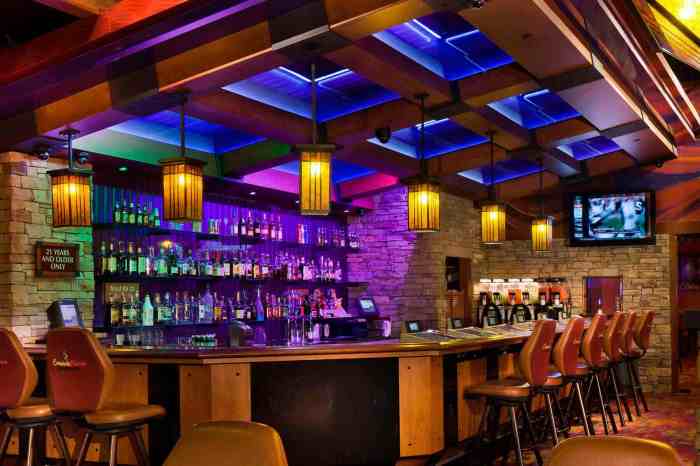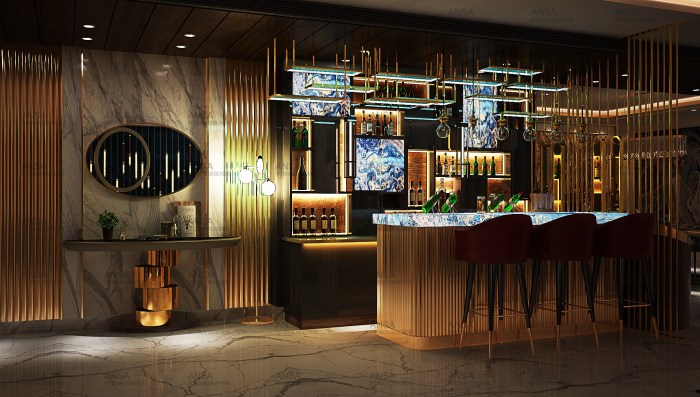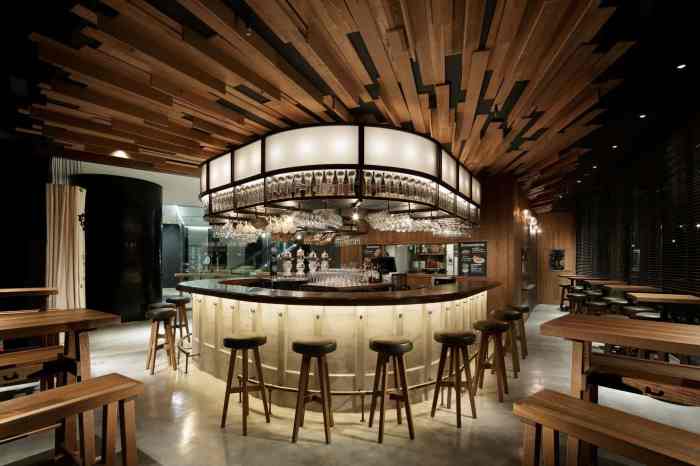Crafting the Perfect Bar Interior Design: A Comprehensive Guide
As bar interior design takes center stage, this opening passage beckons readers into a world crafted with good knowledge, ensuring a reading experience that is both absorbing and distinctly original. Dive into the intricate details of lighting, furniture selection, color schemes, layout optimization, materials, textures, style, and themes that shape the ambiance of a bar.
Explore the fusion of functionality and aesthetics, as we unravel the secrets behind creating a captivating bar interior design that leaves a lasting impression on patrons.
Elements of Bar Interior Design
When it comes to designing a bar interior, several elements play a crucial role in creating the overall ambiance and setting the right mood for patrons. From lighting to furniture selection and color schemes, each component contributes to the overall experience.
Role of Lighting in Creating Ambiance
Lighting is a key element in setting the mood of a bar. Whether it's dim and cozy lighting for a relaxed atmosphere or bright and vibrant lights for a lively vibe, the right lighting can enhance the overall experience for customers.
Strategic placement of lights can highlight certain areas of the bar and create a visually appealing ambiance.
Importance of Furniture Selection for Comfort and Style
The furniture selection in a bar is crucial for both comfort and style. Comfortable seating arrangements encourage patrons to stay longer and enjoy their time at the bar. At the same time, stylish furniture pieces can enhance the overall aesthetic appeal of the space.
Choosing the right mix of seating options, from bar stools to lounge chairs, is essential for creating a welcoming environment.
Use of Color Schemes to Evoke Certain Moods
Color schemes play a significant role in evoking specific moods in a bar setting. Warm tones like red and orange can create a cozy and intimate atmosphere, while cool tones like blue and green can promote a more relaxed and calming environment.
The right combination of colors can set the tone for the overall experience, influencing how patrons feel during their visit.
Layout and Space Planning
When it comes to bar interior design, optimizing the layout and space planning is crucial in creating a functional and inviting environment for customers. A well-thought-out layout can enhance the overall experience and flow of the bar, ultimately leading to increased customer satisfaction and revenue.
Optimizing Bar Layout for Traffic Flow
Efficient traffic flow is essential in a bar setting to ensure that customers can move around easily and access different areas without congestion. Here are some key factors to consider:
- Position the bar counter strategically to allow bartenders to serve customers efficiently and minimize wait times.
- Create clear pathways between seating areas, the bar, and other key areas like restrooms and the entrance.
- Avoid cluttering the space with unnecessary furniture or decor that can obstruct movement.
Significance of Zoning Different Areas Within the Bar
Zoning different areas within the bar helps create distinct spaces with specific functions, catering to varying customer preferences and needs. Some common zones include:
- The bar area for socializing and enjoying drinks.
- A lounge area for more relaxed seating and conversation.
- A dance floor for customers who want to dance and enjoy music.
By zoning different areas, you can create a dynamic and versatile environment that appeals to a wider range of customers.
Balance Between Seating Capacity and Space Utilization
Finding the right balance between seating capacity and space utilization is essential in maximizing the bar's revenue potential while maintaining a comfortable and inviting atmosphere. Consider the following tips:
- Choose furniture that is both functional and space-efficient, such as bar stools that can be easily stacked when not in use.
- Experiment with different seating arrangements to find the optimal layout that allows for both social interaction and individual comfort.
- Regularly assess and adjust the seating capacity based on customer feedback and demand to ensure optimal space utilization.
Materials and Textures

When it comes to designing the interior of a bar, the choice of materials and textures plays a crucial role in creating the right ambiance and style
Best Materials for Bar Countertops and Surfaces
- Granite: Known for its durability and resistance to heat and scratches, granite is a popular choice for bar countertops. It comes in a variety of colors and patterns, adding a touch of elegance to the bar.
- Quartz: Another durable option, quartz is non-porous, making it resistant to stains and easy to clean. It is available in a wide range of colors and finishes, allowing for customization to suit the bar's design aesthetic.
- Stainless Steel: Ideal for a modern and industrial look, stainless steel is a hygienic and easy-to-maintain material for bar surfaces. It is also resistant to heat, stains, and corrosion.
Impact of Textures on Overall Aesthetics
Textures can significantly impact the overall aesthetics of a bar interior design. Incorporating different textures such as smooth, rough, shiny, or matte can add depth and visual interest to the space. For example, combining a sleek granite countertop with textured wood paneling can create a dynamic and inviting atmosphere.
Choosing Durable yet Visually Appealing Materials
When selecting materials for bar countertops and surfaces, it is essential to find a balance between durability and visual appeal. Opt for materials that are not only resistant to stains, heat, and scratches but also complement the overall design theme of the bar.
Consider factors like maintenance requirements, longevity, and budget constraints when making your decision.
Style and Theme

When it comes to designing a bar interior, the style and theme play a crucial role in creating a unique and inviting atmosphere for customers to enjoy. Incorporating a specific theme can help set the tone and enhance the overall experience for patrons.
Consistency in style throughout the bar is key to creating a cohesive and visually appealing space. Balancing trendy elements with timeless design features ensures that the bar remains relevant and attractive for years to come.
Incorporating a Specific Theme
One way to incorporate a specific theme into the design is to use elements such as color scheme, furniture, lighting, and decor that are consistent with the chosen theme. For example, if the theme is a tropical beach bar, you can use bright and vibrant colors, natural materials like bamboo and rattan, and beach-inspired decor such as surfboards and palm leaves.
Importance of Consistency in Style
Consistency in style is important because it helps create a cohesive look and feel throughout the bar. This ensures that all elements work together harmoniously to create a visually appealing space. Whether the style is modern, industrial, rustic, or vintage, maintaining consistency in the design will help establish the overall ambiance of the bar.
Balancing Trendy and Timeless Design
While it's important to incorporate trendy elements to keep the bar looking fresh and current, it's equally important to include timeless design features that will stand the test of time. This could be achieved by investing in quality furniture and fixtures, choosing classic color palettes, and incorporating versatile design elements that can easily be updated with small changes.
Last Word

In conclusion, bar interior design is a delicate balance of artistry and functionality, where every element plays a crucial role in shaping the overall experience. By understanding the nuances of lighting, layout, materials, and style, one can transform a simple bar into a unique and inviting space that resonates with visitors.
Dive into the world of bar interior design and unleash your creativity to craft spaces that tell a story and create unforgettable memories.
Commonly Asked Questions
What role does lighting play in creating ambiance?
Lighting sets the mood and ambiance of a bar, creating a welcoming or intimate atmosphere depending on the design and placement of lights.
How do you optimize bar layout for traffic flow?
Optimizing bar layout involves ensuring easy access to the bar, strategically placing seating areas, and creating clear pathways for movement.
What materials are best for bar countertops and surfaces?
Durable materials like granite, quartz, or stainless steel are popular choices for bar countertops due to their longevity and ease of maintenance.
How can you incorporate a specific theme into bar design?
To incorporate a theme, use cohesive color schemes, thematic decor elements, and unique architectural details that reflect the concept you want to convey.